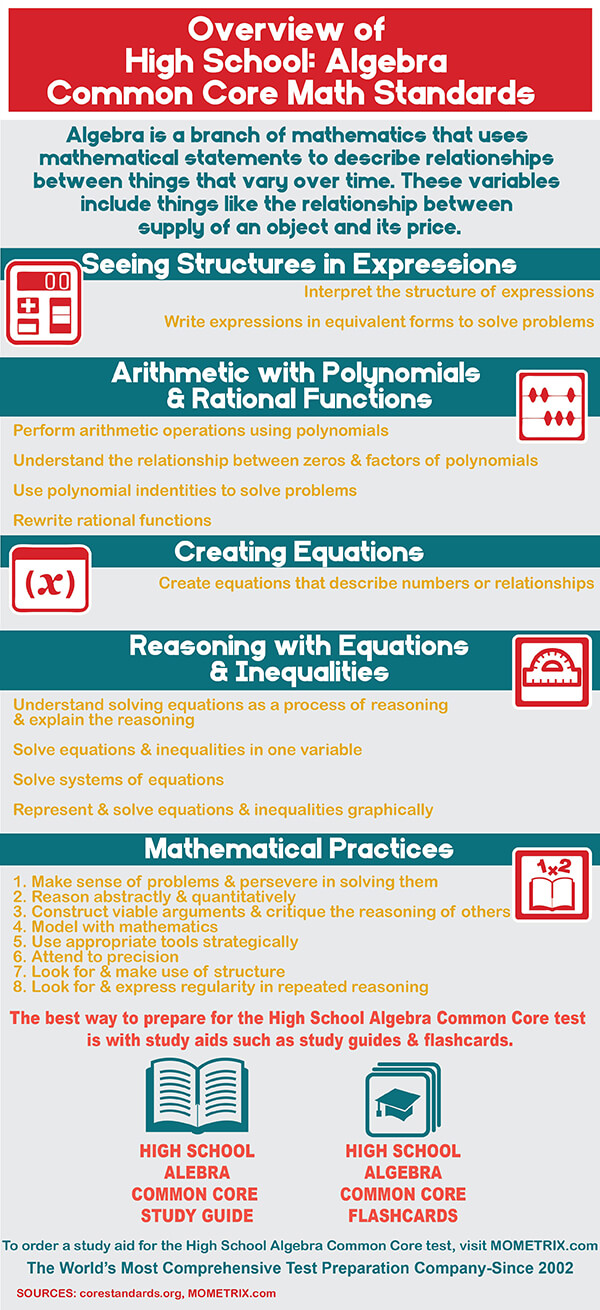1. Given the expression, 6x2-9(x-4)+2, which of the following represents a coefficient?
- 6
- 9
- -4
- 2
2. How many terms are included in the expression, 2x2+12x-8+10x?
- 3
- 4
- 5
- 6
3. Which of the following represents a factor in the formula, S.A.=πr(l+r)?
- 2πr
- πr2
- l+r
- πrl
4. Which of the following expressions is equivalent to (x-3)2?
- x2-3x+9
- x2-6x-9
- x2-6x+9
- x2+3x-9
5. Which of the following represents the factors of the expression, x2-3x-40?
- (x-8)(x+5)
- (x-7)(x+4)
- (x+10)(x-4)
- (x+6)(x-9)
6. Which of the following represents the zeros of the expression, x2-2x-24?
- a. x=4 and x=6
- x=-4 and x=6
- x=4 and x=-6
- x=-4 and x=-6
7. What are the zeros of a quadratic expression, represented by the factors, (x+6)and (x-7)?
- x=6 and x=7
- x=6 and x=-7
- x=-6 and x=7
- x=-6 and x=-7
8. What is the minimum value of the expression 3x2-6x+6 ?
- 3
- (x+3/2)26
- (x-9/4)215
- (x+1/8)2-3
9. Which of the following expressions are equivalent to (5/8)3?
- 53/83
- 53/8
- 5/83
- (8/5)(1/3)
10. Kevin saves 2 dollars during the month of January. Each month, he plans to save twice the amount saved during the previous month. With this plan, how much will he have saved after 18 months?
- $218,174
- $262,144
- $478,195
- $524,286
Answers and Explanations
1. A: A coefficient is the number in front of any term containing a variable or variables. In this case, 6 is the coefficient of 6x2. If -9 were distributed across(x-4)the given binomial, -9 would be the coefficient of-9x. However, Choice B is the positive integer, 9. The other two choices represent constants in the expression.
2. B: A term is a part of an expression that may include a number and/or variable(s) that is separated from other parts of the expression by the operations of addition and/or subtraction. In the given expression, there are four terms, namely 2x2, 12x, ?8, and 10x.
3. C: A factor of an algebraic equation is similar to a factor in a multiplication problem; it is a quantity that is multiplied by another quantity to give a product. In this case, the quantity, (l + r), is multiplied by the quantity, ?r. Thus, (l + r) is a factor in the given formula.
4. C: The expression can be written as (x-3)(x-3). Distribution gives x2-3x-3x+9. Combining like terms gives x2-6x+9.
5. A: The expression may be factored as (x-8)(x+5). The factorization may be checked by distributing each term in the first factor over each term in the second factor. Doing so gives x2+5x-8x-40, which can be rewritten as x2-3x-40.
6. B: The quadratic expression may be factored as (x-6)(x+4). Setting each factor equal to 0 gives x-6=0and x+4=0. Solving for x gives x=6 and x=-4.
7. C: The zeros of an expression are the points at which the corresponding y-values are 0. Thus, the zeros of the expression, represented by the given factors, will occur at the x-values that have corresponding y-values of 0. Setting each factor equal to 0 gives x+6=0and x-7=0. Solving for x gives x=-6 and x=7. Thus, the zeros of the expression are x=-6and x=7.
8. A: The technique of completing the square may be used to reveal the minimum value of the parabola. In order to have a coefficient of 1, for the term, 3x2, each term should be divided by 3. Doing so gives x2-2x + 2. The expression may be set equal to 0, in order to reveal the zeros of the function. Doing so gives: x2-2x + 2=0. The addition property of equality allows the 2 to be subtracted from both sides of the equation, giving x2 – 1/2 x=-2. In order to complete the square, the coefficient of the x-term should be divided by 2 and then squared. This result should then be added to both sides of the equation. Thus, the equation can be rewritten as x2-2x+1=. -2+1. The left hand side of the equation can be factored as (x-1)2; this expression must be zero or positive. Setting the expression equal to zero will reveal the value, x=1, yielding the minimum value of the quadratic expression. Evaluating the original expression at x = 1 gives 3(1)2-6(1)+6=3. The minimum value of the expression is 3.
9. A: One of the properties of exponents states the following: (a/b)n= an/bn . Therefore, the given expression can also be written as 53/83 . 10. D: The situation describes a geometric series, with a common ratio of 2. The formula for finding the sum of a finite geometric series is Sn=(a1 (1-rn)/(1-r), where Snrepresents the sum of n terms, a1 represents the value of the initial term, r represents the common ratio, and n represents the number of terms. Substituting 2 for a1, 2 for r, and 18 for n gives: S18=2(1-218)/(1-2) or S18=524,286. Thus, he would save $524,286 during the course of 18 months.



